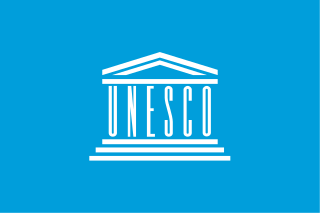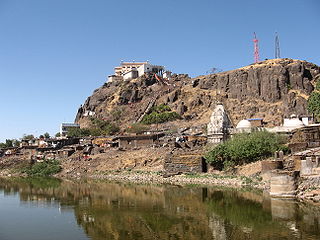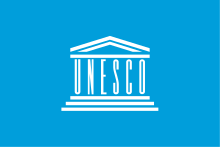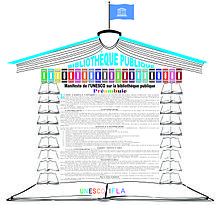
The national flag of Romania is a tricolour. The Constitution of Romania states that "The flag of Romania is tricolour; the colours are arranged vertically in the following order from the flagpole: blue, yellow, red". The flag has a width-length ratio of 2:3; the proportions, shades of colour as well as the flag protocol were established by law in 1994, and extended in 2001.
International Literacy Day is an international observance, celebrated each year on 8 September, that was declared by UNESCO on 26 October 1966 at the 14th session of UNESCO's General Conference. It was celebrated for the first time in 1967. Its aim is to highlight the importance of literacy to individuals, communities and societies. Celebrations take place in several countries.

The World Heritage Committee is a committee of the United Nations Educational, Scientific and Cultural Organization that selects the sites to be listed as UNESCO World Heritage Sites, including the World Heritage List and the List of World Heritage in Danger, defines the use of the World Heritage Fund and allocates financial assistance upon requests from States Parties. It comprises representatives from 21 state parties that are elected by the General Assembly of States Parties for a four-year term. These parties vote on decisions and proposals related to the World Heritage Convention and World Heritage List.

The World Heritage Convention, formally the Convention Concerning the Protection of the World Cultural and Natural Heritage, is an international treaty signed on 23 November 1972, which created the World Heritage Sites, with the primary goals of nature conservation and the preservation of cultural properties. The convention, a signed document of international agreement, guides the work of the World Heritage Committee. It was developed over a seven-year period (1965–1972).

The United Nations Educational, Scientific and Cultural Organization (UNESCO) is a specialized agency of the United Nations (UN) aimed at promoting world peace and security through international cooperation in education, arts, sciences and culture. It has 194 member states and 12 associate members, as well as partners in the non-governmental, intergovernmental and private sector. Headquartered in Paris, France, UNESCO has 53 regional field offices and 199 national commissions that facilitate its global mandate.
The first inscriptions on the UNESCO Memory of the World International Register were made in 1997. By creating a compendium of the world’s documentary heritage – manuscripts, oral traditions, audio-visual materials, library and archive holdings – the program aims to tap on its networks of experts to exchange information and raise resources for the preservation, digitization, and dissemination of documentary materials. As of 2018, 432 documentary heritages have been included in the Register, among them recordings of folk music, ancient languages and phonetics, aged remnants of religious and secular manuscripts, collective lifetime works of renowned giants of literature, science and music, copies of landmark motion pictures and short films, and accounts documenting changes in the world’s political, economic and social stage. Of these, 24 properties were nominated by countries from the region of Africa.
The first inscriptions on the UNESCO Memory of the World International Register were made in 1997. By creating a compendium of the world's documentary heritage—manuscripts, oral traditions, audio-visual materials, library and archive holdings – the program aims to tap on its networks of experts to exchange information and raise resources for the preservation, digitization, and dissemination of documentary materials. As of 2018, 432 documentary heritages have been included in the Register, among them recordings of folk music, ancient languages and phonetics, aged remnants of religious and secular manuscripts, collective lifetime works of renowned giants of literature, science and music, copies of landmark motion pictures and short films, and accounts documenting changes in the world's political, economic and social stage. Of these, thirteen properties were nominated by countries from the region of the Arab States.
The first inscriptions on UNESCO's Memory of the World Register were made in 1997. By creating a compendium of the world’s documentary heritage, including manuscripts, oral traditions, audio-visual materials, library and archive holdings, the program aims to promote the exchange of information among experts and raise resources for the preservation, digitization, and dissemination of documentary materials. As of December 2018, 429 main documentary heritages had been inscribed in the Register, with 116 of these from Asia and the Pacific.

The International Register of the UNESCO Memory of the World-Programme includes inscriptions from Europe and North America. As of December 2018, the region has 274 inscriptions of the 432 total inscriptions included in the Register.
The first inscriptions on the UNESCO Memory of the World International Register were made in 1997. By creating a compendium of the world's documentary heritage—manuscripts, oral traditions, audio-visual materials, library and archive holdings – the program aims to tap on its networks of experts to exchange information and raise resources for the preservation, digitization, and dissemination of documentary materials. As of 2018, 432 documentary heritages have been included in the Register, among them recordings of folk music, ancient languages and phonetics, aged remnants of religious and secular manuscripts, collective lifetime works of renowned giants of literature, science and music, copies of landmark motion pictures and short films, and accounts documenting changes in the world's political, economic and social stage. Of these, seven properties were nominated by international organizations.
The first inscriptions on the UNESCO Memory of the World International Register were made in 1997. By creating a compendium of the world’s documentary heritage—manuscripts, oral traditions, audio-visual materials, library and archive holdings – the program aims to tap on its networks of experts to exchange information and raise resources for the preservation, digitization, and dissemination of documentary materials. As of 2018, 432 documentary heritages have been included in the Register, among them recordings of folk music, ancient languages and phonetics, aged remnants of religious and secular manuscripts, collective lifetime works of renowned giants of literature, science and music, copies of landmark motion pictures and short films, and accounts documenting changes in the world’s political, economic and social stage. Of these, 93 properties were nominated by countries from the region of Latin America and the Caribbean.

Jikey or Yikey is a form of traditional religious dance originated from India and commonly practiced by communities in several Southeast Asian countries such as Cambodia, Malaysia, Thailand, and Vietnam. Specifically, there are two major types of Jikey in Thailand, the one in central region tend to have more Buddhist characteristic adopted its original Indian form, meanwhile in the southern region it bear more Islamic characteristic as it is heavily influenced by the Persian and Arabs-derived culture which characterized by the usage of Middle Eastern musical instruments such as the tambourine, etc.

Vamana temple is a Hindu temple dedicated to Vamana, an avatar of the god Vishnu. The temple was built between 1050 and 1075. It forms part of the Khajuraho Group of Monuments, a UNESCO World Heritage Site listed because of its exceptional architecture, art, and testimony to the Chandela dynasty.

The UNESCO 1970 Convention on the Means of Prohibiting and Preventing the Illicit Import, Export and Transfer of Ownership of Cultural Property is an international treaty to combat the illegal trade in cultural items. It was signed on 14 November 1970 and came into effect on 24 April 1972. As of October 2022, 142 states have ratified the treaty.

Pavagadh Hill is situated within a plain in Panchmahal district, Gujarat, western India. A volcanic eruption occurred in the region approximately 500 million years ago and the etymology of Pavagadh is associated with this eruption: Pav-gadh means "one fourth hill" or "fire-hill". At its base is the historical city of Champaner, while the hill station of Pavagadh was built upon the volcanic cone itself. With Champaner, Pavagadh hill forms the Champaner-Pavagadh Archaeological Park, a UNESCO World Heritage Site which is spread over an area of more than 1,329 hectares. Known for its forts, there are also dozens of heritage structures on the hill. The site is 50 kilometres (31 mi) east of Vadodara and 68 kilometres (42 mi) south of Godhra.
AAAAA (5A) is awarded to the most important and best-maintained tourist attractions in the People's Republic of China, given the highest level in the rating categories used by the Ministry of Culture and Tourism. As of 2020, there are 279 tourist attractions listed as 5A.









